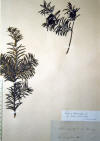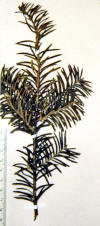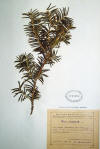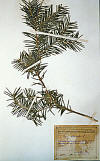|
16f. Taxus baccata var. fructo-lutea
Loudon, Arb. Brit. 4: 2068 (1838), T. b. [var.] fruto-luteo); T. baccata f. luteo-baccata
Pilger, Pflanzenreich 18(iv, 5): 115 (1903); T. baccata f. luteibaccata
Pilger, Mitt. Deutsch. Dendrol. Ges. 25: 12 (1916); T. baccata f. lutea
(Endl.) Rehder, Bibl. cult. trees 2 (1949); T. baccata lutea
Endlicher, Syn. conif., 243 (1847). Type: Ireland? (discovered by Whitlaw
of Dublin about 1817 fide den Ouden & Boom 1965). Original herbarium
material unknown, native origin questionable. Type undetermined.
Spelling corrected according to ICBN 23.5; Taxus is traditionally
feminine (ICBN 62.2).
Branchlets and leaf arrangement intermediate between T. recurvata
var. linearis and var. glauca; the branchlets appearing
erect; leaves appearing radial near apex of branchlet, ±two ranked below,
spreading widely, recurved, notably deficient in papillae on the abaxial
surface, lacking papillae across (5-) 815 cells in the marginal zone, papillae
variable on midrib, stomata in 9-13 rows/band; aril yellow or red.
Yellow-aril yew. Distribution: Caucasus Mts., Europe (Ireland)?
Japan?
Representative Specimens. Lange 259,
det. by Florin as T. baccata L. f. luteo-baccata (S:
C-2189). Transcaucasia Azerbaijan: pr. pag. Kish., in
silvis montanis regionis madian, Brzhezitzky & Kasumov H196 (P,
US).
Taxus baccata var. fructo-lutea
has been recognized strictly based on the development of a yellow aril.
This in itself is not considered worthy of taxonomic merit as a variety.
But the overall morphology of the specimens that seem to belong here show
features that are intermediate between T. recurvata and T.
baccata var. glauca. Additionally, the specimens deviate
in one or more leaf anatomical features that would generally place them in
the Baccata Alliance; thus, all of these features
collectively justify separate taxonomic status. The specimen
annotated by Florin had 1213 stomata rows in a stomata band, instead of
the usual 810 rows, while the other specimens, which had the normal
stomata count differed in having a broad region of marginal cells, 1015
cells wide. Thus, var. fructo-lutea has some leaf anatomical
features that would place it in the Cuspidata Alliance. In this
regard it is interesting that T. cuspidata var. luteobaccata
Miyabe & Tatew. has also been recognized based on natural occurring plants
in Japan (Ohwi 1965). In the European region, reports of yews with a
yellow aril are known from occurrences near Dublin, and that plants grown
from yellow arillocarpia will produce yellow arillocarpia (Elwes and Henry 1906).
Additionally, I have observed a Barron yew at Kew gardens with yellow
arils, and herbarium specimens of a Barron yew are referred to T.
baccata var. variegata.
It might be noted that the presence of
yellow aril is not evident on any of the specimens cited, or from data on
labels, although the specimen annotated by Florin does have several seeds
with aril remnants. Florin, who was an expert on the taxonomy of Taxaceae,
would seemed to have knowledge that the yew specimen, Lange 259,
must have had a yellow aril.
Other specimens from Transcaucasia that
might prove to be more closely related are Woronowa (S: C-2027),
referred to T. recurvata, and Bush (K), identified as T.
baccata var. dovastoniana. The Woronowa specimen
was found to have 13 stomata rows with the leaf margin appearing entirely
papillose, whereas the Bush specimen had a broad leaf margin, 1014
cells, with 11 stomata rows.
|







